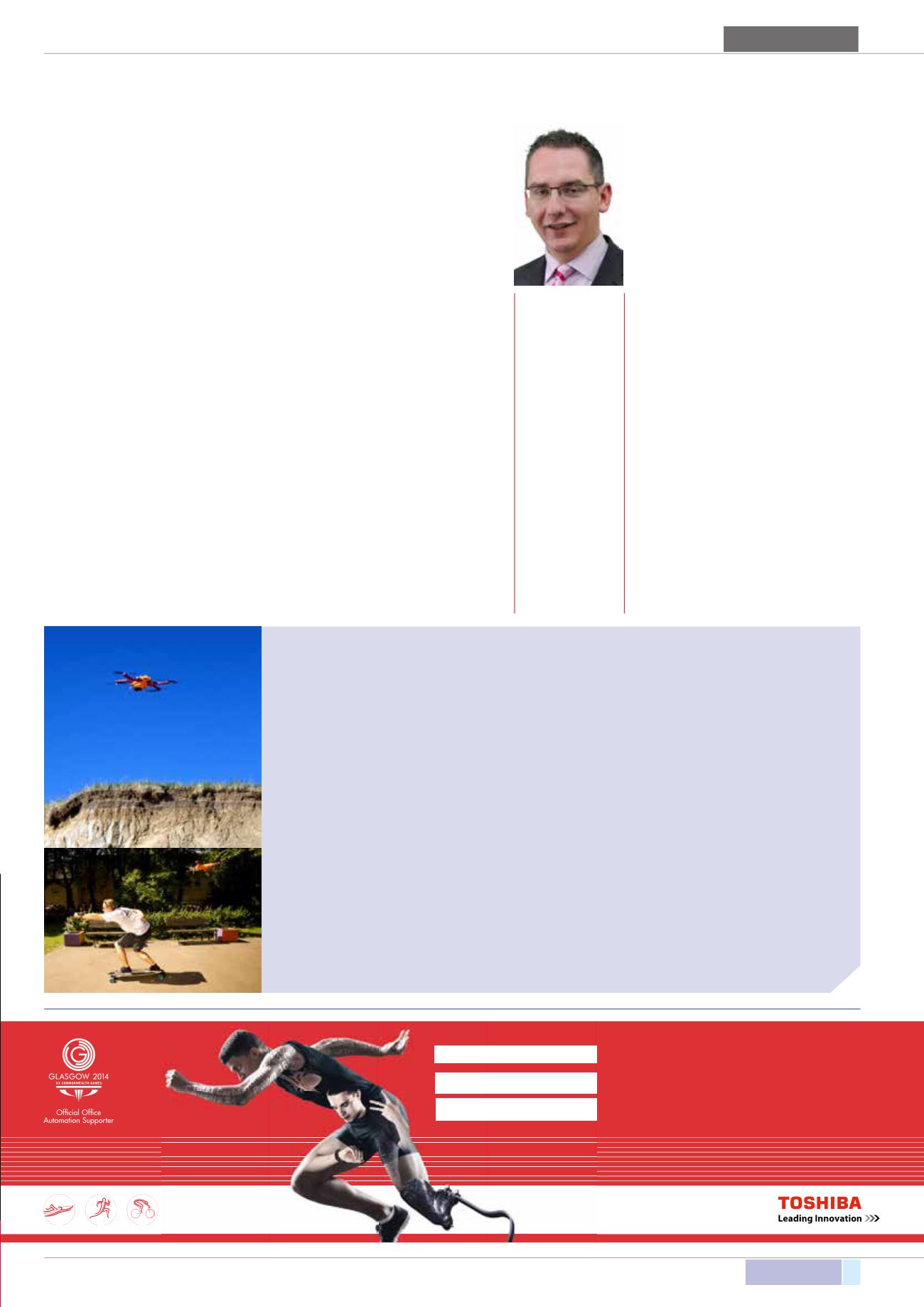
eseller
.co.uk
Print.IT Reseller 17
opinion
...we
can’t see
accountants
and solicitors
needing a
3D printer in
their offices
Toshiba TEC is the official office
automation supporter of the
Glasgow 2014 Commonwealth Games.
A5675
rtoria St ip Ad.indd 1
10/06/2014 16:15
don’t see it as the Holy Grail of office
printing but I don’t believe it is a fad either;
it has a place in the printing world, but
there is still no substitute for A4 paper!”
Andrew Jones:
“As a result of our
extensive research, any client requests for
3D printing will be forwarded to one of
the main manufacturers who will work in
partnership with 1st Office and ensure the
client gets best value.”
Gary Downey:
“The dramatic fall in entry
level costs and the range and durability
of substrates have made the number
of applications far more than the initial
modelling and prototyping areas, but
other considerations, such as the source
of the 3D artwork files, will become more
important and may limit the rate of growth
in other applications.
“It’s certainly not going away and it
is important we really understand what
it can deliver commercially and how we
can provide and support it as part of our
portfolio.”
Mark Smyth:
“If you promote your
business as a provider of printing
technology and a specialist reseller in
print, 3D printing must be considered, and
whilst it’s still somewhat of an unknown,
you cannot afford to overlook what could
potentially be the next best thing in print.
Also, as the market develops, I believe new
uses for 3D printing will emerge and not
being involved early on will only make it
harder for some resellers.”
Peter Knight:
“I don’t think we would go
quite so far as to call it the Holy Grail just
yet, although we definitely won’t be totally
dismissing 3D printing as a passing fad.
“As it stands, the market for 3D printing
is relatively niche. For example, we can’t
see accountants and solicitors needing a
3D printer in their offices. Also, the way
the technology is currently means that
knowledge, skills and support are of huge
importance when it comes to selling 3D
printers. You cannot just ship a 3D printer
to a customer without being able to offer
that continued support, otherwise the device
will be coming back quicker than the time it
takes to print out a simple chess piece!
“Going back to the main point, the
idea that 3D printing possibilities are
endless, that’s something that we here at
Printerbase agree with: there is so much
potential. Everyone, in a wide variety
of industries, is still in the process of
discovering the uses, benefits and assessing
the long-term impact of 3D printing. We
believe that some 3D printing applications
will come and go. However, others will be
developed and become part of our working
environment. 3D printing is part of the
future, there’s no doubt about that.”
Karl Welburn:
“I don’t think it will impact
our offerings. However, I do believe this is a
fad that is here to stay.”
AirDog, the first automated drone designed to
track and video outdoor activities, is a good
example of how 3D printing can help inventors
quickly turn ideas into operational prototypes.
Aimed at the consumer market, the AirDog is a
simple-to-use, ‘quad-copter’ that operates via a wrist-
worn tracking device. Having set distance, speed and
height levels for AirDog to follow, users can capture
live aerial video footage and still photography of
themselves on the integrated GoPro sports camera.
Helico, developer of the AirDog, expects it to
prove popular with fans of freestyle BMX, motocross,
skateboarding, surfing, kite-surfing and wake-boarding,
when it is launched commercially at the end of October.
Edgars Rozentals, co-founder and CEO of Latvia-
based Helico Aerospace Industries, said that 3D
printing was critical in helping AirDog get off the
ground, both literally and figuratively, as the original
silicon-moulded parts, ordered from a supplier in
China, took two weeks to produce and were ultimately
too heavy for lift-off and had to be scrapped.
“The benefits delivered by 3D printing compared
to the method we trialled originally are numerous,”
he said. “Above all, turnaround time is significantly
reduced and if we need to make last minute
changes to a design, we can do so within a matter
of hours, easily and cost-effectively. This was simply
unachievable before, as it necessitated time-
consuming production of a costly new mould.”
Stratasys’ Latvian partner Baltic3D, working with
Polish reseller Bibus Menos, recommended Stratasys
FDM printing for the AirDog, as the FDM-based
ULTEM material is able to create parts of great
strength and durability that are still light enough for
take-off and in-flight manoeuvrability.
The accompanying AirLeash tracking device was
printed using Stratasys’ PolyJet multi-material 3D
printing technology. The wrist-worn device with both
rigid and soft parts (e.g. the case and keypad buttons)
was 3D printed in a single pass.
Follow the leader
Peter Knight
,
Founder,
Printerbase
continued...


